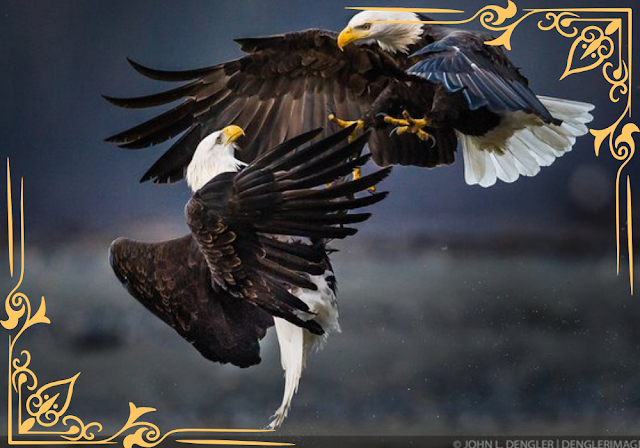Eagle Behavior Patterns: Unraveling the Mysteries of the Majestic Birds of Prey
Eagles, these awe-inspiring avian predators, are renowned for their formidable strength, piercing vision, and extraordinary hunting prowess. To truly grasp the essence of these magnificent birds, it is essential to delve into the intricacies of their behavior. In this exploration, we uncover the hidden facets of eagle behavior, from their masterful hunting techniques and intricate social dynamics to their strategic migration patterns and communication methods.
Hunting Techniques and Feeding Habits
Eagles, as apex predators, are primarily carnivorous, relying on their razor-sharp talons and formidable beaks to subdue their prey. Their hunting behavior is a study in patience and precision, a dance of strategy and timing. These raptors are known to soar effortlessly at dizzying heights, their sharp eyes scanning the ground below for the slightest movement. Once a target is identified, the eagle morphs from a serene glider into a missile, plummeting earthward at speeds that can exceed 100 miles per hour. The sheer velocity of their descent, coupled with the element of surprise, ensures that their prey seldom escapes.
But there is more to their hunting prowess than sheer speed. Eagles exhibit an impressive adaptability in their hunting methods, which vary dramatically depending on the type of prey and the environment. Some species prefer the vast openness of fields, where their speed and agility give them an edge, while others navigate dense forests or rugged mountainous terrain with astonishing deftness. This adaptability is a testament to their intelligence, highlighting their role as versatile hunters capable of modifying their strategies to suit their surroundings.
Social Behavior and Territoriality
Though often seen as solitary creatures, eagles display a spectrum of social behaviors, particularly evident during the breeding season. Unlike many birds, eagles tend to be monogamous, forming deep, enduring bonds with a single mate. The courtship rituals of eagles are a sight to behold, characterized by dramatic aerial displays where the pair lock talons mid-flight, spiraling toward the earth in a mesmerizing dance. These acrobatic displays are not mere performances but critical components of their bonding and territorial claims.
Territoriality plays a pivotal role in eagle behavior. These birds are fiercely protective of their domain, especially their nesting sites and hunting grounds. An eagle will engage in aggressive posturing and even physical confrontations to defend its territory from intruders. This behavior ensures not only the safety of their immediate environment but also creates a secure space for raising their young. Their nests, or eyries, are architectural marvels, often constructed in remote, elevated locations, safe from predators and harsh weather, safeguarding their offspring from the moment they are laid as eggs.
Migration Patterns and Seasonal Movements
Migration in eagles varies widely among species; some are sedentary, staying within the same territory year-round, while others undertake extensive migrations influenced by the changing seasons and food availability. For example, the Bald Eagle and the Golden Eagle of North America migrate vast distances to access more abundant hunting grounds or more temperate climates. This migratory behavior is not random but follows well-established routes honed over generations, demonstrating a deep-seated knowledge of the landscape and its resources.
Eagle migrations are usually solitary endeavors or involve small familial groups, a contrast to the large flocks seen in other bird species. The triggers for these migrations are multifaceted, encompassing climatic conditions, the availability of prey, and the timing of breeding cycles. Understanding these migrations is crucial, especially in light of conservation efforts aimed at protecting eagle populations from the threats posed by habitat destruction and human encroachment.
Communication and Vocalization
While not as vocally expressive as some of their avian counterparts, eagles employ a range of vocalizations and physical gestures to communicate. Their calls vary from soft, intimate exchanges between mates to piercing screeches that serve as warnings to potential rivals or threats. These vocalizations are integral to their social structure, particularly during the breeding season when maintaining a strong pair bond is vital.
Beyond their calls, eagles are masters of non-verbal communication. Subtle shifts in body posture, wing positioning, and even nuanced changes in their flight patterns convey a wealth of information, from signaling aggression to indicating a readiness to mate. These silent messages are as vital to their communication repertoire as their vocalizations, offering a rich tapestry of behaviors that researchers can study to gain deeper insights into their social dynamics and survival strategies.
Conclusion
Eagles, with their striking behavioral patterns, are more than just majestic birds of prey; they are complex, adaptable, and intelligent creatures. Their hunting techniques, social interactions, migration habits, and communication methods are all finely tuned to enhance their survival and dominance in the wild. By studying these behaviors, we not only gain a greater appreciation for these incredible birds but also underscore the importance of conserving their natural habitats.
The world of eagles is one of constant adaptation and resilience, a testament to their enduring spirit and the raw beauty of the natural world. Whether gliding effortlessly above mountain peaks or diving with lethal precision toward unsuspecting prey, eagles epitomize the untamed spirit of the wild, embodying a blend of power, grace, and survival instinct that continues to captivate and inspire.




